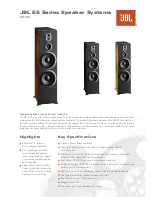
Widescreen Review • Issue 86 • July 2004
2
Page 2/4
Equipment
Review
power button is required to turn off the pro-
jector to avoid accidental turn-off, which
would reduce bulb life.
The Owner’s Manual is unusually thor-
ough and is almost completely devoid of
marketing hype. It offers many suggestions
that will help the average user extract maxi-
mum performance from the projector.
Inputs And Signal
Compatibility
There are five main inputs, composite
video (RCA jack), S-video (4-pin mini-DIN),
Input A and Input B (5 RCA jacks each),
and an HDMI Digital input (HDMI connec-
tor). The composite input accepts virtually
all world television standards. Input A and
Input B can be configured for component,
RGB-TV, or RGB-PC operation. The HDMI
input accepts RGB digital signals and can
be used with products having a DVI output
by using a DVI to HDMI cable (not provid-
ed). Inputs A and B accept 480i, 480p,
720p, and 1080i as well as a large number
of computer formats. The HDMI input
accepts RGB 480p, 720p, 1080i, and com-
puter formats.
Menus
The main menu is divided into four
parts, the Image Menu, the Setup Menu, the
Info Menu, and the Reset Menu. The main
menu window can be located on any part of
the screen, and a simplified line menu func-
tion is provided for frequently used picture
adjustments. The menu system is extremely
comprehensive and flexible. It is intuitive
and easy to use, although my detailed
description may make it seem complicated.
The Image Menu is divided into Picture
Quality, Color Adjustment, Picture Mode,
Memory Save, Auto Setup, and Reset.
Picture Quality includes the Input parame-
ters (White and Black Level), Iris, Color
Intensity, Tint, and Sharpness. Tracking and
Sync adjustments are provided for some
input signals. Color Adjustment includes
Absolute Color Temperature (500K incre-
ments from 5000K to 10000K), Flesh Tone
(raises or lowers green), and an overall
RGB adjustment for Offset, Gain, and
Gamma (used to calibrate gray scale track-
ing). Picture Modes include Dynamic,
Bright, Standard, Cinema, Cinema Black, or
PC. Memory Save allows picture settings to
be saved to any of six memories, which can
be directly selected by dedicated buttons
on the remote.
The Signal Menu is divided into Signal,
Screen, Operation, User’s Logo, On-Screen
Display, Input Signal, Language, and Reset.
Signal provides a choice of Film/Auto or
forced Video Progressive modes. Motion
Detection adjusts the video deinterlacer.
Two levels of Noise Reduction plus Off can
be selected. Overscan can be set to either
4 percent or 0 percent (default on HDTV is
0 percent). Setup Level can be set to 7.5
IRE or 0 IRE. The HDMI input can be set to
Normal (maps video levels 16 to 235 to 0 to
255) or expanded (0 to 255).
Screen allows adjustment of Position,
Caption Zoom, Electronic Keystone (normal-
ly not needed, and should be avoided to
prevent artifacts), and Projection position
(front floor, front ceiling, rear floor, rear ceil-
ing). Operation includes Sleep Mode, Lamp
Power, Standby Mode, Trigger Output,
Settings Lock (Focus, Zoom, or Keylock),
and LCD Panel Alignment. Any image can
be captured and assigned as a User Logo.
The On-Screen Display can be moved and
its color changed. The Line Menu can be
turned on or off, and the Menu Color can be
changed. The Hide Screen can be Black,
Blue, or the User Logo, and the Startup
Screen can be turned on or off. Language and
Reset are the final items in the Signal Menu.
The Info Menu displays the Lamp Hours,
Source, and depending on the type of sig-
nal —Input Signal, Source Resolution,
Refresh Rate, or Sync Mode.
The Reset Menu includes the lamp timer,
picture memories, and a master reset.
Aspect Ratios
The aspect ratio choices are Normal,
Squeeze, Zoom, Smart Zoom, Through, and
Squeeze Through. Normal provides a 4:3
(1.33:1) windowboxed image when the
source has a 4:3 aspect ratio, and provides
a 16:9 (1.78:1) image on HDTV. The aspect
ratio on HDTV is not adjustable (all HDTV is
1.78:1, even when displaying upconverted
regular programs with side bars). Squeeze
is the proper setting for 1.78:1 (anamorphic)
DVDs. Zoom is the proper setting for 1.33:1
letterboxed DVDs. Smart Zoom is a modi-
fied geometry mode used to display 1.33:1
images using full screen width with minimal
observed geometry distortion. Through and
Through Squeeze are pixel-by-pixel
mapped modes similar to Normal and
Squeeze (for non HDTV images).
Scaling And
Deinterlacing
Scaling and deinterlacing is excellent in
all modes. A Genesis (Faroudja) DCDi
™
chip
is used for processing and contributes to
the excellent performance. I viewed a vari-
ety of demanding deinterlacing test pat-
terns on
AVIA PRO
and the Microsoft WHQL
test discs and results were generally very
good for both film and video sourced mate-
rial. Identification of the 2-3 cadence and
switching to film mode (inverse telecine)
took about 0.25 seconds. I also viewed the
“Montage Of Images” on the original
Video
Essentials
, and the continual switching from
video to film sourced material was seam-
less. I also viewed the Sony DRC demo
disc, which is all HDTV video sourced mate-
rial, downconverted for DVD, and results
86yamahareprint 6/15/04 2:14 PM Page 2






















